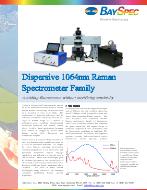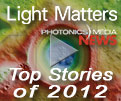 |
 |
|
 |
| |
| Nanobubbles Destroy Some Cells, Treat Others |
 |
A single laser blast can activate plasmonic nanobubbles that selectively kill diseased cells while at the same time treating others, and leaving neighboring healthy cells untouched. The unique tunable plasmonic nanobubble technique developed at Rice University shows promise for replacing several difficult processes now used to treat cancer patients, among others, with a fast, simple, multifunctional procedure. |
|
|
|
|
 |
|
 |
| X-ray Laser Helps Fight Sleeping Sickness |
| A weak spot in the parasite that causes African sleeping sickness, a disease that kills an estimated 30,000 people each year, has been mapped using an x-ray laser, pinpointing a promising new target for treating the fly-borne illness. An international group used the SLAC National Accelerator Laboratory’s Linac Coherent Light Source (LCLS) to study African trypanosomiasis, a disease transmitted by tsetse flies infected with the single-celled parasite Trypanosoma brucei. About 60 million people across Africa are at risk for contracting the disease. |
|
|
|
| Pinnacle Biologics Acquires PDT Laser Tech |
| Pinnacle Biologics Inc. has completed its portfolio of photodynamic therapy treatment components with the acquisition of Diomed’s PDT 630 laser and fiber optic diffuser Optiguide. |
|
|
|
Featured White Paper
|
|
 |
|
 |
| |
 |
Dispersive 1064nm Raman Spectrometer Family
BaySpec, Inc.
Owing to technological improvements spurred on by the telecommunications boom of the last decade, Raman spectroscopy has become much more accessible to users in all fields. The combination of improved technology and the technique’s molecular sensitivity have led to a surge in Raman usage in a myriad of application areas, including pharmaceutical, biomedical, industrial, and forensic, among others. In all of these applications, however, there remains a struggle to extract useful Raman spectra from fluorescent and luminescent samples.
DOWNLOAD WHITE PAPER >> |
|
|
 |
|
 |
| NIR Imaging Gets Big Boost |
| Studying arterial diseases and therapies just got easier, thanks to a new fluorescence imaging technique that allows researchers to visualize the blood flow of living animals with unprecedented clarity. The Stanford University technique involves shining a laser over a living subject after water-soluble carbon nanotubes have been injected into its bloodstream. The NIR wavelength light (about 0.8 µm) causes the specially designed nanotubes to fluoresce at a longer wavelength of 1 to 1.14 µm, which is then detected to determine the blood vessels’ structure. |
|
|
|
| Photonics West Boasts Largest Program Yet |
| SPIE Photonics West will set records again this year, thanks to its largest-ever biomedical technical program and BiOS Expo, which are driving growth for the 2013 event. |
|
|
|
| Choosing the Right Microscopy System |
| For any job, there is the right tool. But understanding how to evaluate your equipment and recognize its limitations could be the key to raising the standard of the science you carry out. The technology surrounding microscopy systems is evolving at an astounding and sometimes overwhelming pace. Keeping up with technological advances could improve the quality of data extracted from an imaging system, but often microscopy users consider a new system only when they find that their existing equipment falls short. |
|
|
|
|
| |
 |
In this edition of the industry's premier weekly newscast, we bring you the top research stories of 2012, according to photonics.com readers. Hosted by Photonics Media's Melinda Rose and Laura Marshall. |
|
|
| Live-Cell Imaging Uses All the Best Acronyms |
| Researchers are working to improve FRET, TIRF, FLIM, FRAP and other microscopy methods to get the most accurate data possible. This may be an obvious statement, but live-cell microscopy is an important, even integral, tool in biomedical research. In studies of cell biology, neurobiology, pharmacology and more, it has enabled insights that would not have been possible by imaging fixed cells. |
|
|
|
| Fourier Domain OCT Guides QCL Thermal Therapy |
| Researchers share their demonstrations of real-time monitoring of 6.1-µm quantum cascade laser-based ablation and coagulation. Thanks to advances in laser therapy, lasers are now irreplaceable tools in modern medicine. Many laser systems are becoming standard instruments for surgical procedures. |
|
|
|
| The Silk (Optics) Road |
| An eco-friendly material that once united Europe and Asia in transcontinental trade shows promise for manipulating light in biosensors and more. Fiorenzo Omenetto, a biomedical engineering professor, heads the Laboratory for Ultrafast Nonlinear Optics and Biophotonics at Tufts University in Medford, Mass., where they are using silk in brand-new ways. |
|
|
|
| Industry Events |
|
 |
|
 |
| |
SPIE BiOS 2013 - February 2 - 7, 2013 · San Francisco, CA
Visit us at Booth 8600 |
 |
BiOS is part of SPIE Photonics West, the laser, opto-electronics, photonics, and imaging event in North America, with over 5,000 technical attendees from over 50 countries. Special events include hot topics presentations, the international biomedical optics exhibit, with industry leading working groups and panels.
MORE EVENTS >> |
|
|
 |
|
 |
|
|

Follow Photonics Media on Facebook and Twitter
|
  |
|
sponsor
 sponsor
 |
sponsor
.jpg) sponsor
 |
|
|